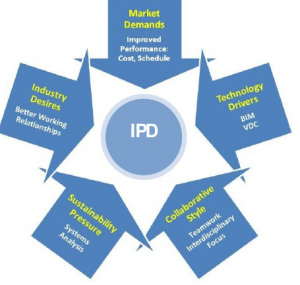Automated Highway System
December 23, 2020
Engineering Production
December 23, 2020Introduction
The present century’s era is driven by industrial evolution of technology, which has become more effective and sound by the introduction of Integrated Project Delivery (IPD) systems. Further the significance of building Information Modeling (BIM) along with the integration of IPD has attained significance among professionals, architects and designers. This report is aimed to discuss the strengths and restrictions of delivery systems such as BIM and also to determine/address the following three research questions:
- How do implications of such systems enable reduction in errors?
- Are there prospects of greater cost certainty through adaptation of such systems?
- What are the strengths and limitations of the Integrated Project Delivery (IPD) approach in reducing risks?
Integrated Project Delivery (IPD)
Before presenting the case of BIM which is the focus of this research, it is important to lay the background of the broader concept of Integrated Project Delivery (IPD) system, a unique methodology/approach defined by the American Institute of Architects as the delivery process which incorporates parameters such as; systems, individuals, business structures and various practices combined at one point. These parameters/resources are then utilized for reducing waste and optimization of available resources by maximizing their efficiency. IPD is such an exceptional method that it can be easily applied to phases of designing, assemblage and then to construction (AIA, 2012).

The IPD principle is applicable to varied sets of contractual events and the corresponding IPD teams are composed of owners, architects and contractors. In any case the complete integration of the project is done by the owner, leading designer and primary constructor who will be responsible for initiation of the project till the complete project handover.
IDP is a method of project delivery that work with system, business, people and all the participants in an agreement. This actually works with the talent present in an enterprise. It is a methodology to run a project by giving incentives and assigning goals to team members so that the project is carried out effectively with minimum resource waste and maximizing company’s productivity. It guides the construction team in all areas of construction including beginning from development of infrastructure to final touches like fabrication. It also works closely with stakeholders and develops a communication between team and stakeholders to inform them about every development on the project. Its key objective is to involve each department of company on equal basis to achieve transparent and 100% results (Cook & Lott, 2007). BIM, on the other hand is engineered project delivery tool, which has been derived from the concept of the IDP, details of which has been outlined in the following section.
Building Information Modeling (BIM)
BIM is relatively a new model used to design, plan and develop buildings/projects. It has actually revolutionized the way how engineers and practitioners treated the infrastructure and how utilities were designed and planned around the infrastructure. The BIM tool supports the practitioners in coming up for solution to the problems that have been faced by them previously. The integrated project delivery team works in collaboration with information processed through the BIM, to assess and understand the underlying problems and to come up with an effective solution for these issues. This model is effectively used for exchanging information between different models and people working on a project (McNell et al., 2014).
How does an Integrated Project Delivery with BIM enhance the project’s productivity?
The most common challenges in the field of construction are cost, time, design and fulfilling the business needs. Mistakes in these fields ultimately cost the whole project and people involved in it. To minimize errors in these areas IPD develops a road map with six steps which leads to successful completion of projects. These steps are discussed as below:
Understand the value proposition
Misunderstanding the value in an organization is the common error. So first focus of IPD is outline where and how value can be generated in an organization and ensure that the whole industry is getting benefit. This allows the engineers to yield greater productivity and usability of their designs. The companies can benefit through it by having a better sequence of construction and manufacture. To know the value in an organization is critical because it is responsible for the foundation of IPD in an organization (Salman, 2011).
Despite most of the companies’ just focus on gaining profit working on this point not only minimizes the cost but also induce better staff participation and greater energy in completion of a project. By gaining an insight understanding of business cases the investment as well as the processes involved can be validated. This value proposition helps in evaluating improvement through specifying business measures (Hornsby & Allan, 2012).
Set requirements
After the values have been set clear all the underlying processes are then mapped. For successful implementation of a process structured approach should be adopted, which is strategized by the IPD approach. This not only help the system to function properly and also aid in smooth implementation of a program and there will be less chances of error. For better results in completion of project requirements it is advisable to consult with the company’s shareholders. This allows a transparent development with the involvement of every one important (Forbes & Ahmed, 2010).
Understand the information requirements
To have successful error free construction plan it is very necessary to gather basic data of all the requirements in early stages of designing the infrastructure. This will help to eliminate flaws throughout the construction and management process. IPD is quite subjective in defining how an organization is treating the data because it the assets on which the whole project will be standing. Any error or mistake in the provided information can adversely affect the final results (Kent & Becerik-Gerber, 2010). However the data strategy used by IPD should be free of any intellectual property theft or liability concerns.
Choose the technology
Choosing the appropriate technology for a project is the main focus of IPD approach. In this approach the technology has been evolved constantly according to the user need. For example projects like building a nuclear plant requires technology that not only caters the geographic part but also aid in developing the facility keeping in mind the sensitivity of operations that have to be carried there. This technology must be chosen after careful evaluation of all the requirements in the given project (Dykstra, 2011).
Implement the change
For a company to adapt IPD approach, it is necessary that they must evaluate the strengths and capabilities of their staff members who actually have to carry out the proposed changes, such as implementation of BIM modelling in their project. If the methodology used is new then there is need of proper training to the existing staff so that they can successfully implement the process. The transfer of knowledge for those who have been working with BIM is also a company asset that can be used in any future plan. Therefore the company should implement changes according to the IPD plan and requirements (Kensek, 2014).
Realize the Benefits
After implementing the system, the possible benefits can be realized very easily. There it is important to evaluate the metrics that will tell that whether the benefits are same as the values set in initial stages. If not then changes have to be made to achieve the targeted values. Tracking progress and monitoring values helps in achieving continuous improvement and there is a low chance of loss.
Using IPD in Estimating Cost Certainty
IPD approach greatly influence the way how the budget is being treated and there is a continuous monitoring on exceeding and reducing cost on the project. There is usually no chance of exceeding the estimated cost because all the steps in this process are quite coordinated. The estimated cost has been set in the light of opinions, considerations and experience of the professional team members. In addition the constant monitoring and evaluation reduces the chance of cost exceeding the estimated budget.
In a project the shareholders and participants actually take a risk on their profit after investing in a particular project. They obviously don’t want the cost to be overrun and ultimately cost them. Therefore the integrated project delivery also considers this possibility and adds this “dealing with a risk situation” in its plan. This planning of dealing with the risk situation helps greatly in dealing with greater cost certainty (Deutsch, 2011). IPD with BIM integrated following principles for budgeting to reduce cost errors in a project:
- Effective and improvised administration of the construction project by eliminating any difficulty or communication problem between the owner and the planner, designer and the contractor’s teams
- Taking steps to complete the project within given budget by optimized construction and procurement strategies; after careful consideration of the project requirements and risk assumptions by different teams.
- Reducing the chances of increased or overrun budget through effective management. This is possible due to the increase level of communications and precise construction and budgetary planning through IPD
- Educating architect with the cost effectiveness of the project through access to the construction and current prices. This information is provided to them in the initial stages of the design making. Different tool such as BIM play highly influential role in this regard
- Estimating costs of each developmental phase in the beginning.
- Taking steps to make sure there is no legal claim of additional budget or compensation in future (Kent & Becerik-Gerber, 2010).
Cost Estimation
The basic elements in cost estimation process are the pricing and quantity take off. These quantities can be obtained in a cost database by integrated in the building information model. However this model does not help in obtaining pricing. To estimate the cost of a project a cost estimator expert is required to estimate and analyze the cost of every material used in that project and how they should be installed. The pricing of each step is available in the data base however if it is missing for a step then it is the responsibility of cost estimator that he should study more deeply and come out with accurate pricing solution (Azhar et al., 2009).
For example if there is an activity of pouring concrete then the budget of everything such as wire mesh, concrete rebar etc. and their quantity to be used should be defined by BIM. This model will counter every single detail about every single thing involved in the activity. The cost estimator should evaluate each unit price, material cost, labor cost and even estimated profits, the labor unit will involve the mobilization, their working duration and wages and material cost include the sum of all the materials that will be used. Once the unit prices are obtained the cost of the entire project is then estimated by multiplying the total quantity extracted from the BIM. The data input and output is quite good in BIM approach. For successful implication of BIM it is important that the architect and the constructor agree on basic components definitions. Only then there would be successful results (Gudnason & Scherer, 2012).
Strength and Limitation of IPD in Reducing Risks
Integrated Project Delivery (IPD) is an emerging innovation in construction delivery. It usually conceives the owner, the architect or engineer and the contractor, all entering into a single contract and operating as a collaborative team to design and develop the project with shared risks and reward in the final cost, schedule, and quality of the larger project. Simply stated, IPD is like a joint venture strategy to design and construction. It reflects a radical deviation from conventional delivery methods that isolate responsibilities, liabilities, communication, risks, and rewards with contract that are often lacking in an impetus collaborate and work toward the shared objective of a successful overall project.
IPD is a growing delivery strategy based on broad concepts that can be tailored on a project-by-project basis. While is no concrete description of IPD, the following basic concepts are generally present:
One Integrated Agreement
The main team members, including the owner, the architect or engineer, and the contractor all enter into a single contract. Either method of contracting for IPD manifests a considerably different contractual design from Design Bid Build, in which the owner enters into separate contracts with the architect/engineer and the general contractor, both of whom are accountable solely to the owner.
Shared Risk and Reward
The main IPD team members manage and share risks and rewards in the results of the project, generally its cost and time of completion, but any number of performance indicators can be established, including quality, sustainability, minority hiring, etc.
One method with IPD is to split the compensation of each core team member into three categories: direct cost, overhead and profit, and bonus.
Collaboration
Rather than each party having its own on-site office, IPD projects involve a so called ‘big room’ in which all parties are stationed together to be able exchange idea, collaborate, and function as a team. The IPD contract must stipulate how BIM or other technology will be used, specifically in terms of input, access, alterations, confidentiality, copyright ownership, technological capability, dependability on data provided by others and restricted or complete responsibility for errors.
Joint Decision-Making
To make decisions with regards to the project, approval may be required of all stakeholders, votes may be weighted, veto power may vested in certain team members or the owner may reserve the privilege to take a decision when the team members are unable to arrive at a consensus.
Dispute and Liability Avoidance
A hallmark of IPD is minimizing the risk of disputes, liability, and litigation in order to promote cooperation and team environment. The project team member may agree upon different methods to appropriately limit liability: they may excuse each other from liability for good faith errors in judgment, even if negligence is found, accept, of course, to the extent that deliberate misconduct prevails.
Advantages of Integrated Project Delivery
IPD can prove to a potentially beneficially all participants in the design and construction of a project. Some of its specific possible advantages are stated below:
- Cost savings for the owner (possibly, the costs of construction, operations, and maintenance) as a result from the incentive for the team members to earn bonuses.
- Rapid conclusion of the project for owner, again as a result of the incentive for the team members to earn bonuses.
- Bonuses given out to the designers and contractors for accomplishing cost savings, faster completion of the project as well as other project objectives.
- Minimized risk of design and construction defects as a result of the collaborative, teamwork strategy
- Minimized liability for the designers and contractors as a result of the acknowledged limitations of liability and dispute aversion
Disadvantages of Integrated Project Delivery
IPD is not meant for everyone and it may not live up to it maximum advantage. Some of its shortcomings are stated below:
- Highly expert designers or contractors may not be familiar with IPD and be reluctant to take part in an IPD project
- Getting all of the main IPD team members to arrive at a consensus on one kind of a party agreement could well prove to be impossible or frustrating.
- An owner may face challenges obtaining financing because lenders are not familiar with IPD or may not like its strategy for various reasons, such as the potential for bonuses to be paid of the limitations of liability.
- Limiting liability fundamentally implies that the party that suffers the economic damages or other detrimental consequences would be left ‘holding the bag’ (the insurance industry is in the process of reviewing possible products to insure against such risks to facilitate IPD.
- The bonus incentive system requires that budgets and schedules be carefully checked to make sure that they are fair and appropriate and not excessive.
- The teamwork approach must be endorsed by strong leadership and management to ensure active, enthusiastic, and positive participation and avert lax participation – IPD is not meant for the laid back or slack workers.
Conclusion
IPD is designed solely on collaboration which is in turn based on trust. As teams are structured the entire focus is on project outcome as opposed to the traditional approach in which individual goal is kept in focus. The best thing is presence of mutual trust and respect towards the team members and also required involvement by every party. Compensation is awarded to the teams which have obtained project goals by utilizing innovative business models through collaboration and efficiency.
The traditional method of project delivery is based on fragments which are assembled on just as need basis and then again they are strongly hierarchical and controlled completely by higher management. The processes which are linear, distinct and segregated into sub tasks according to teams’ knowledge and expertise. The risk factor involved in such projects is high at individual level which is then transferred to greatest extent possible. Further this process promotes innovation and a culture of exceptional high-class performance. During this phase of construction the project is ascertained through intensifies planning which increases efficiency and increase savings. As responsibilities are clearly defined hence identification and resolution of problems are done immediately without any individual liability. The complete team is responsible for any error hence disputes are resolved promptly.
IPD is possibly the most enthralling innovation to emerge in the design and construction industry in decades. With the possibility of considerable cost saving and efficiencies rarely witnessed under the conventional delivery methods, and with the lure of camaraderie, and a collaborative, team work environment, IPD could become the leading delivery method in the industry.
References
AIA, 2012. Conceptual approach for Integrated Project Delivery (IPD) & Building Information Modeling (BIM). [Online] Available at: https://web.iit.edu/sites/web/files/departments/academic-affairs/Academic%20Resource%20Center/pdfs/integrated_project_delivery.pdf [Accessed 26 November 2015].
Azhar, S., Brown, J. & Farooqui, R., 2009. BIM-based sustainability analysis: An evaluation of building performance analysis software. Proceedings of the 45th ASC Annual Conference, 1.
Cook, R. & Lott, F., 2007. Integrated Project Delivery: A Guide. [Online] Available at: http://www.aia.org/groups/aia/documents/pdf/aiab083423.pdf [Accessed 27 November 2014].
Demkin, J.A., 2008. The Architect's Handbook of Professional Practice. Joseph A. Demkin, American Institute of Architects.
Deutsch, R., 2011. BIM and Integrated Design: Strategies for Architectural Practice. John Wiley & Sons.
Dykstra, A., 2011. Construction Project Management: A Complete Introduction. Alison Dykstra.
Forbes, L.H. & Ahmed, S.M., 2010. Modern Construction: Lean Project Delivery and Integrated Practices. CRC Press.
Gudnason, G. & Scherer, R., 2012. eWork and eBusiness in Architecture, Engineering and Construction: ECPPM 2012. CRC Press.
Hornsby, S. & Allan, J., 2012. Building Information Modelling: The BIM Revolution. [Online] Available at: https://www.ibm.com/smarterplanet/global/files/building_information_modelling_ibm_pov.pdf [Accessed 28 November 2015].
Kensek, K.M., 2014. Building Information Modeling. Routledge.
Kent, D.C. & Becerik-Gerber, B., 2010. Understanding construction industry experience and attitudes toward integrated project delivery. ournal of construction engineering and management..
McNell, D., Allison, H., Black, W. & Cukrow, M., 2014. Building Information Modeling. [Online] Available at: http://www.infocomm.org/cps/rde/xbcr/infocomm/Brochure_BIM.pdf [Accessed 27 November 2015].
Salman, A., 2011. Building information modeling (BIM): Trends, benefits, risks, and challenges for the AEC industry. Leadership and Management in Engineering.
Get 3+ Free Dissertation Topics within 24 hours?


























